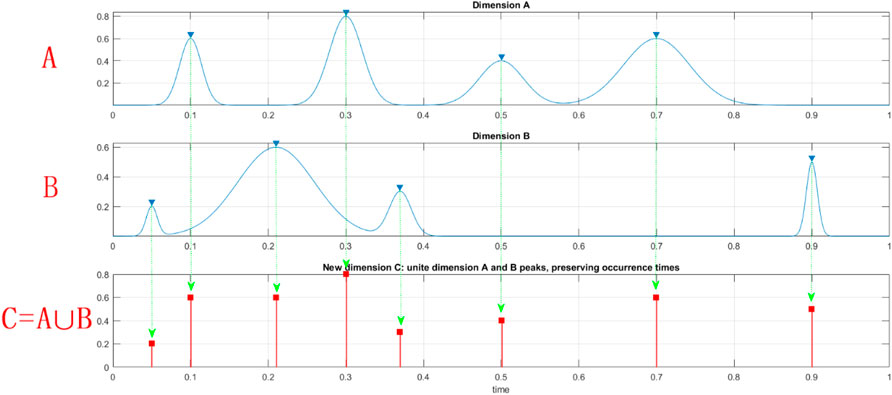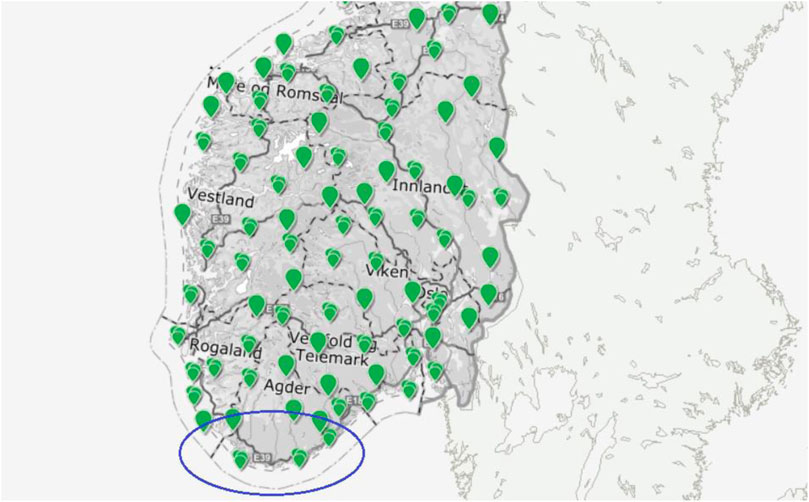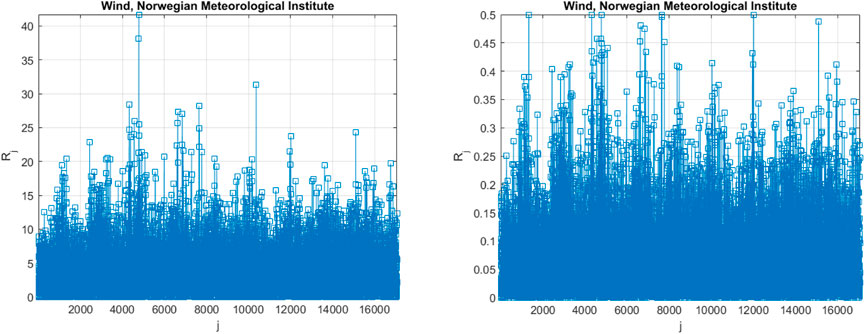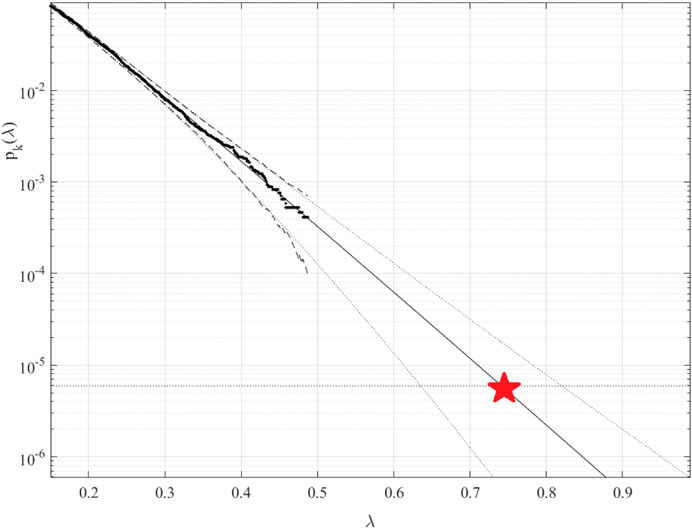- 1Shanghai Ocean University, Shanghai, China
- 2University of Stavanger, Stavanger, Norway
The paper describes a novel structural reliability method, particularly suitable for multi-dimensional environmental systems, either measured or numerically simulated over a sufficient period, resulting in sufficiently long ergodic time series. This study illustrates the efficiency of the proposed methodology by applying it to predict extreme wind speeds of a group of selected measured sites in Southern Norway in the region near the Landvik wind station. It is well known that wind speeds at different locations are highly non-linear, multi-dimensional and cross-correlated dynamic environmental responses, which can be challenging to analyse accurately. Unlike other environmental reliability methods, the new method does not require restarting the simulation each time the system fails, e.g., in the case of numerical simulation. In the case of measured environmental system response, an accurate prediction of system failure probability is also possible, as illustrated in this study. Moreover, in contrast to classical reliability methods, the proposed method can handle systems with high dimensionality and cross-correlation between the different dimensions.
Highlights
⁃ A novel environmental reliability method has been developed and applied to wind speeds data measured in southern Norway
⁃ Accurate multi-state prediction is performed
⁃ Confidence bands are given
Introduction
In many practical situations, it would be useful to improve the accuracy of in situ wind speeds statistical predictions, as wind speeds are the key part of environmental loads acting on offshore structures and vessels. In this paper, the specific issue of improving extreme wind speed prediction has been addressed. The latter would typically be possible if the location in question has a measurement station more or less in the same area where the recording of wind speed statistics has been going on for several years. In Norway, there is a grid of such stations located at, e.g., airports and lighthouses. This paper has chosen wind speed time series from a group of selected measured sites in Southern Norway in the region near the Landvik wind station.
It is generally relatively challenging to calculate realistic environmental system reliability using conventional theoretical reliability methods (Madsen et al., 1986; Thoft-Christensen and Murotsu, 1986; Ditlevsen and Madsen, 1996; Melchers, 1999; Choi et at. 2007; Eryilmaz and Kan, 2020; Kan et al., 2020; Zheng et al., 2020). This is usually due to a large number of degrees of system freedom and random variables governing the responses in a real environmental system. In principle, the reliability of a complex environmental system may be accurately estimated straightforwardly either by having enough measurements or by direct Monte Carlo simulations (Naess and Leira and Batsevych, 2009). However, the experimental or computational cost may be unaffordable for many complex dynamic systems in which the long-term statistics of their responses can only be accurately captured using huge data sets. Motivated by the latter argument, the authors have introduced a novel reliability method for environmental systems that uses the average conditional exceedance rate (ACER) method (Naess and Gaidai, 2009; Gaidai et al., 2020; Gao et al., 2020; Sun et al., 2022) for statistical extrapolation to reduce either measurement or computational costs. Extreme value statistics has been a topical matter for some time now, and there are some excellent reviews on the topic, see (Hansen, 2020; Majumdar et al., 2020).
The shortage of previous studies on wind speed predictions is that most of the existing relevant statistical methods are unidimensional (1D) or, at most, bivariate (2D). In the case of multiple measurement locations studied simultaneously, there is a vital need to develop new efficient reliability methods that can tackle cross-correlation between different dimensions (measurements). This study intends to contribute to the latter research challenge.
Data and methodology
Method
Consider an MDOF (multi-degree of freedom) structure subjected to random ergodic environmental loadings (stationary and homogenous), for example, from the surrounding waves and wind. The other alternative is to view the process as dependent on specific environmental parameters whose variation in time may be modelled as an ergodic process on its own. The MDOF structural response vector process
Let
with
being the probability of non-exceedance for critical values of response components
In practice, however, it is not feasible to estimate the latter joint probability distribution directly
Next, the local maxima time instants

FIGURE 1. Illustration of synthetic
Next, a scaling parameter
The following outlines the principle behind a cascade of approximations based on conditioning. The first approximation is a one-step memory approximation and thus resembles a Markov chain approximation. However, it is emphasised that this first approximation is not equivalent to such an approximation (Karpa, 2015). In practice, the dependence between the neighbouring
for
where
Eq. 5 presents subsequent refinements of the statistical independence assumption. The latter type of approximations captures the statistical dependence effect between neighbouring maxima with increased accuracy. Since the original MDOF process
Note that Eq. 6 follows from Eq. 1 by neglecting
Note that Eq. 5 is similar to the well-known mean up-crossing rate equation for the probability of exceedance (Gaidai et al., 2020; Gao et al., 2020; Naess and Gaidai, 2009). There is evident convergence with respect to the conditioning parameter
Note that Eq. 6 for
where
Rice’s formula gives the mean up-crossing rate in Eq. 8 with
In the above, the stationarity assumption has been used. The proposed methodology can also treat the non-stationary case. An illustration of how the methodology can be used to treat non-stationary cases is provided as follows. Consider a scattered diagram of
with
Model introduction
The Naess-Gaidai extrapolation model (Naess and Moan, 2013; Gaidai et al., 2022; Xing et al., 2022; Xu et al., 2022) is briefly introduced as it will be used as a basis for the failure probability distribution tail extrapolation. The method assumes that the class of parametric functions needed for extrapolation in the general case can be modelled similarly to the relation between the Gumbel distribution and the general extreme value (GEV) distribution. The above introduced
Next, by plotting
with
The weight function
For any general ergodic process, the sequence of conditional exceedances over a threshold
with
Note that the authors have successfully verified the accuracy of the Naess-Gaidai extrapolation model in previous years for a large variety of one-dimensional dynamic systems (Gaidai et al., 2020; Gao et al., 2020; Naess and Gaidai, 2009; Sun et al., 2022).
Data introduction
This section intends to illustrate the efficiency of the above-described methodology, utilising the method to predict the extreme wind speeds at a group of selected measured sites in Southern Norway near the Landvik wind station. The five wind measurement locations are Landvik, Kjevik, Lindesnes Fyr, Lista Fyr and Oksøy Fyr. Their measured daily highest daily wind cast speeds are defined as five environmental system components (dimensions)
Figure 2 presents wind measurement locations according to the Norwegian Meteorological Institute, 2021. The blue circle indicates the area of interest. The daily largest wind cast speed at the Landvik location during the years 2010–2020 is shown in Figure 3.
making all five responses non-dimensional and having the same failure limit equal to 1.

FIGURE 2. Wind speed measurements locations according to Norwegian Meteorological Institute. The blue circle indicates the area of interest.

FIGURE 3. Daily largest wind cast speed at Landvik location during the years 2010–2020 (Norwegian Meteorological Institute, https://seklima.met.no/). In order to unify all five measured time series
Next, all the local maxima from five measured time series are merged into one single time series by keeping them in time non-decreasing order:
Figure 4 presents an example of the non-dimensional assembled vector

FIGURE 4. Left: unscaled raw daily largest wind cast speed data [m/sec], Right: scaled non-dimensional assembled 5D vector
Figure 5 presents extrapolation according to Eq. 9 towards failure state with 25 years return period, which is 1, and somewhat beyond,

FIGURE 5. Extrapolation of
As demonstrated, while being novel, the above-described methodology has a clear advantage in efficiently utilising the available measured data set. This is due to its ability to treat system multi-dimensionality, as well as being able to perform accurate extrapolation based on a relatively limited data set.
Conclusion
Classic reliability methods dealing with time series do not have the advantage of dealing efficiently with systems possessing high dimensionality and cross-correlation between different system responses. The key advantage of the introduced methodology is its ability to study the reliability of high-dimensional non-linear dynamic systems.
This paper studied the Norwegian highest largest wind cast speeds data set, in the region near Landvik wind station, observed during the recent decade 2010-2020. A novel environmental reliability method was applied to predict the occurrence of extreme winds in the area of interest within the time horizon of the next 100 years. It is shown that the proposed method produced a reasonable confidence interval. Thus, the suggested methodology may become an appropriate tool for various non-linear dynamic systems reliability studies. Both measured and numerically simulated time series responses can be analysed. Further, unlike other reliability methods, the new method does not require restarting numerical simulation each time it fails, for example, in the case of Monte Carlo simulations. Finally, the suggested methodology can be used in a wide range of engineering areas of applications. [Andersen and Jensen, 2014, Ellermann, 2008, Falzarano et al., 2012, Su, 2012.
Data availability statement
The original contributions presented in the study are included in the article/Supplementary Material, further inquiries can be directed to the corresponding author.
Author contributions
All authors listed have made a substantial, direct, and intellectual contribution to the work and approved it for publication.
Funding
This study was partially supported by the National Natural Science Foundation of China [grant numbers: 52071203]; the authors would like to express their gratitude for supporting the Fishery Engineering and Equipment Innovation Team of Shanghai High-level Local University.
Conflict of interest
The authors declare that the research was conducted in the absence of any commercial or financial relationships that could be construed as a potential conflict of interest.
Publisher’s note
All claims expressed in this article are solely those of the authors and do not necessarily represent those of their affiliated organizations, or those of the publisher, the editors and the reviewers. Any product that may be evaluated in this article, or claim that may be made by its manufacturer, is not guaranteed or endorsed by the publisher.
References
Andersen, J., and Jensen, J. J. (2014). Measurements in a container ship of wave-induced hull girder stresses in excess of design values. Mar. Struct. 37, 54–85. doi:10.1016/j.marstruc.2014.02.006
Choi, S-K., Grandhi, R. V., and Canfield, R. A. (2007). Reliability-based structural design. London: Springer-Verlag.
Ditlevsen, O., and Madsen, H. O. (1996). Structural reliability methods. Chichester (UK): John Wiley & Sons.
Ellermann, K. (2008). IUTAM symposium on fluid-structure interaction in ocean engineering. China: Springer, 45–56. Non-linear dynamics of offshore systems in random seas.
Eryilmaz, S., and Kan, C. (2020). Reliability based modeling and analysis for a wind power system integrated by two wind farms considering wind speed dependence. Reliability Engineering & System Safety 203, 1.
Falzarano, J., Su, Z., and Jamnongpipatkul, A. (2012). “Application of stochastic dynamical system to non-linear ship rolling problems,” in Proceedings of the 11th international conference on the stability of ships and ocean vehicles (Athens, Greece: National Technical University of Athens).
Gaidai, O., Wang, F., Wu, Y., Xing, Y., Medina, A., and Wang, J. (2022). Offshore renewable energy site correlated wind-wave statistics. Probabilistic Eng. Mech. 68, 103207. doi:10.1016/j.probengmech.2022.103207
Gaidai, O., Xu, X., Naess, A., Cheng, Y., Ye, R., and Wang, J. (2020). Bivariate statistics of wind farm support vessel motions while docking. Ships offshore Struct. 16 (2), 135–143. doi:10.1080/17445302.2019.1710936
Hansen, A. (2020). The three extreme value distributions: An introductory review. Front. Phys 8, 604053. doi:10.3389/fphy.2020.604053
Kan, C., Devrim, Y., and Eryilmaz, S. (2020). On the theoretical distribution of the wind farm power when there is a correlation between wind speed and wind turbine availability. Reliability Engineering & System Safety 203, 1.
Karpa, O. (2015). Development of bivariate extreme value distributions for applications in marine technology. Trondheim: Norwegian University of Science and Technology. PhD thesis.
Madsen, H. O., Krenk, S., and Lind, N. C. (1986). Methods of structural safety. Englewood Cliffs: Prentice-Hall.
Majumdar, S. N., Pal, A., and Schehr, G. (2020). Extreme value statistics of correlated random variables: A pedagogical review. Phys. Rep. 840, 1–32. doi:10.1016/j.physrep.2019.10.005
Melchers, R. E. (1999). Structural reliability analysis and prediction. New York: John Wiley & Sons.
Naess, A., and Gaidai, O. (2009). Estimation of extreme values from sampled time series. Struct. Saf. 31 (4), 325–334. doi:10.1016/j.strusafe.2008.06.021
Naess, A., Leira, B. J., and Batsevych, O. (2009). System reliability analysis by enhanced Monte Carlo simulation. Struct. Saf. 31, 349–355. doi:10.1016/j.strusafe.2009.02.004
Naess, A., and Moan, T. (2013). Stochastic dynamics of marine structures. Cambridge: Cambridge University Press.
Norwegian Meteorological Institute (2021). Norwegian meteorological Institute. Available at: https://seklima.met.no/.
Rice, S. O. (1944). Mathematical analysis of random noise. Bell Syst. Tech. J. 23, 282–332. doi:10.1002/j.1538-7305.1944.tb00874.x
Su, Z. (2012). Non-linear response and stability analysis of vessel rolling motion in random waves using stochastic dynamical systems. Texas: Texas University.
Sun, J., Gaidai, O., Wang, F., Naess, A., Wu, Y., Xing, Y., and Chen, M. (2022). Extreme riser experimental loads caused by sea currents in the Gulf of Eilat. Probabilistic Eng. Mech. 68, 103243. doi:10.1016/j.probengmech.2022.103243
Thoft-Christensen, P., and Murotsu, Y. (1986). Application of environmental systems reliability theory. Berlin: Springer-Verlag.
Xing, Y., Gaidai, O., Ma, Y., Naess, A., and Wang, F. (2022). A novel design approach for estimation of extreme responses of a subsea shuttle tanker hovering in ocean current considering aft thruster failure. Appl. Ocean Res. 123. doi:10.1016/j.apor.2022.103179
Xu, X., Wang, F., Gaidai, O., Naess, A., Xing, Y., and Wang, J. (2022). Bivariate statistics of floating offshore wind turbine dynamic response under operational conditions. Ocean. Eng. 257, 111657. doi:10.1016/j.oceaneng.2022.111657
Zheng, C., Liang, F., Yao, J., Dai, J., Gao, z., Hou, T., and Xioan, F. (2020). Seasonal extreme wind speed and gust wind speed: A case study of the China seas. J. Coast. Res. 99, 435–438. doi:10.2112/SI99-059.1
Keywords: reliability, failure probability, environmental system, wind speeds, Southern Norway
Citation: Gaidai O, Yan P and Xing Y (2022) A novel method for prediction of extreme wind speeds across parts of Southern Norway. Front. Environ. Sci. 10:997216. doi: 10.3389/fenvs.2022.997216
Received: 18 July 2022; Accepted: 31 August 2022;
Published: 29 September 2022.
Edited by:
Tirthankar Banerjee, Banaras Hindu University, IndiaReviewed by:
Arnab Pal, Institute of Mathematical Sciences, Chennai, IndiaChong-wei Zheng, National University of Defense Technology, China
Copyright © 2022 Gaidai, Yan and Xing. This is an open-access article distributed under the terms of the Creative Commons Attribution License (CC BY). The use, distribution or reproduction in other forums is permitted, provided the original author(s) and the copyright owner(s) are credited and that the original publication in this journal is cited, in accordance with accepted academic practice. No use, distribution or reproduction is permitted which does not comply with these terms.
*Correspondence: Ping Yan, cHlhbkBzaG91LmVkdS5jbg==
 Oleg Gaidai
Oleg Gaidai Ping Yan1*
Ping Yan1* Yihan Xing
Yihan Xing